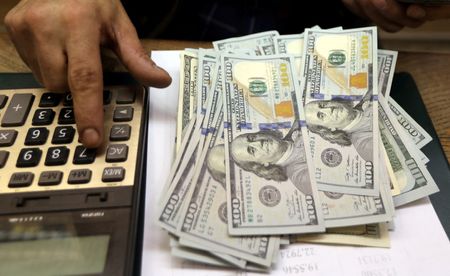
By Chuck Mikolajczak
NEW YORK (Reuters) – The U.S. dollar edged up on Thursday after a flurry of economic data, including weekly labor market numbers, in a more muted move a day after a spike higher following the release of minutes from the Federal Reserve’s December meeting.
The dollar sharply pared losses of as much as 0.44% late Wednesday after the minutes showed Fed policymakers were concerned about rising inflation, which along with a tight labor market, could result in the Fed’s raising rates sooner than anticipated along with a reduction in its asset holdings.
Traders are currently anticipating a greater than 70% chance for a rate hike of at least 25 basis points at the March Fed meeting, according to the CME FedWatch Tool.
“The market is paying attention more to monetary policy and that discrepancy, and that is really what is driving the dollar,” said John Kicklighter, analyst at DailyFX.com in Chicago. “If you are already pricing in, probably, the most aggressive, hawkish view that you are going to get, then how much further is the dollar going to go?”
St. Louis Fed President James Bullard said on Thursday the Fed could raise rates as soon as March and is in a “good position” to be even more aggressive against inflation, as needed.
U.S. labor market data showed weekly initial jobless claims rose by 7,000 to a seasonally adjusted 207,000, slightly above the 197,000 forecast. The data comes after a very strong private payrolls report on Wednesday in the ADP National Employment report and ahead of Friday’s December payrolls report, which could bolster expectations the Fed will become more aggressive in hiking rates.
San Francisco Fed President Mary Daly said the central bank should raise interest rates this year, given the “very strong” labor market and high inflation acting as a “repressive tax” that acts as burden, particularly on the poor.
Other data showed the U.S. trade deficit widened sharply in November to $80.2 billion, indicating a possible weight on fourth-quarter economic growth.
The dollar index rose 0.071% at 96.253.
Analysts view 96.40 for the dollar index as a technical resistance point, with a break above likely to result in a test of the December high of 96.91.
Steven Ricchiuto, U.S. chief economist at Mizuho Securities USA LLC in New York, anticipated the appreciation in the dollar index will continue into early 2022 toward the 98 level, with an “overshoot” to 100 possible.
A report from the Institute for Supply Management showed activity in the U.S. services sector slowed more than expected in December, likely due to a rise in COVID-19 infections. However, investors have viewed the new Omicron variant as unlikely to severely crimp economic activity.
The euro was down 0.17% to $1.1294 as annual inflation in Germany slowed in December for the first time in six months but remained well above the European Central Bank’s 2% target, according to preliminary data on Thursday.
The Japanese yen strengthened 0.26% versus the greenback at 115.82 per dollar, while Sterling was last trading at $1.3532, down 0.16% on the day. Sterling reached a two-month high of 1.3598 on Wednesday.
In cryptocurrencies bitcoin last fell 0.08% to $43,400.97.
(Reporting by Chuck Mikolajczak; Editing by Nick Zieminski and Leslie Adler)

